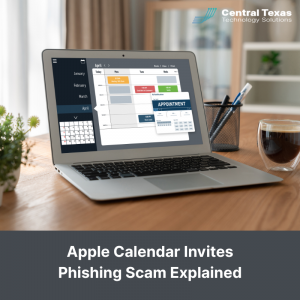
 Cybercriminals are constantly finding new ways to trick even the most cautious professionals, and their latest tactic is hiding inside something as harmless as a calendar invite.
Cybercriminals are constantly finding new ways to trick even the most cautious professionals, and their latest tactic is hiding inside something as harmless as a calendar invite.
The Apple Calendar Invites Phishing Scam is spreading fast, and it’s catching business leaders off guard across every industry. If you or your team rely on Apple devices, understanding how this scam works and how to stop it is essential to protecting your data and reputation.
What Is the Apple Calendar Invites Phishing Scam?
The Apple Calendar invites phishing scam is a deceptive attack where cybercriminals send fraudulent calendar invitations that appear to come from legitimate Apple sources. These invites often include fake alerts about suspicious account activity or payment issues and encourage users to click a link or call a number to resolve the problem.
Once a user interacts with the message, attackers can gain access to sensitive information, install malware, or even take remote control of devices.
At its core, this scam relies on phishing, a common cyberattack that manipulates human trust to steal credentials or financial data. But unlike traditional phishing emails, these calendar-based attacks come directly through Apple’s own systems, making them look credible and difficult to detect.
Why Apple Users Are Especially at Risk
Apple products have a strong reputation for security, which is exactly why this scam is so effective. Many users assume Apple communications are always trustworthy. However, the phishing scam in Apple Calendar invites takes advantage of Apple’s built-in trust system.
- Authentic-looking senders: The fraudulent invites often come from addresses like “noreply [at] email [dot] apple [dot] com” These emails can pass authentication checks like DKIM, DMARC, and SPF, which are typically used to verify legitimate senders.
- False urgency: Messages often claim there’s an unauthorized payment or a locked account, pressuring the user to act quickly.
- Realistic formatting: Because these invites are integrated within Apple’s ecosystem, they blend seamlessly with real notifications.
This combination of credibility and urgency makes the scam especially dangerous for businesses whose teams frequently use iCloud or Apple devices for scheduling.
How the Apple Calendar Invites Phishing Scam Works
Understanding the step-by-step process behind this scam can help your organization spot it before damage occurs:
- The lure – The attacker creates a fake calendar invite, inserting the scam message in the “Notes” section. It might claim there’s a suspicious charge or a PayPal issue that needs immediate attention.
- The spread – These invites are sent to group mailing lists, making it easy for the attack to reach multiple users quickly.
- The hook – The victim calls the provided number or clicks a malicious link, believing they’re resolving an issue.
- The breach – Once the attacker has the victim’s attention, they may ask them to download remote access software, allowing full access to their device or network.
- The fallout – Attackers can then steal login credentials, install ransomware, or transfer funds directly from business accounts.
How to Protect Your Business from the Apple Calendar Invites Phishing Scam
You can’t prevent every scam attempt, but you can dramatically reduce the risk of becoming a victim. Strong cybersecurity awareness and layered protection are key.
Here’s how to stay safe:
- Train your team regularly. Encourage employees to report suspicious invites or notifications before taking any action.
- Use multi-factor authentication (MFA). Even if credentials are compromised, MFA adds an additional barrier to prevent unauthorized access.
- Keep software updated. Always install system and security updates as soon as they’re available. These patches often close vulnerabilities that scammers exploit.
- Partner with an IT provider like CTTS. A proactive IT partner can monitor systems in real time, identify threats early, and strengthen your defenses before attackers strike.
Apple has not yet issued an official fix for this vulnerability, so responsibility falls on users and organizations to safeguard their data. Staying informed, vigilant, and prepared is the best defense.
Why Businesses in Central Texas Trust CTTS
When you work with CTTS, you’re not just getting IT support—you’re gaining a cybersecurity partner dedicated to protecting your people, data, and reputation. From phishing prevention and employee training to 24/7 monitoring and incident response, our team helps Central Texas businesses stay ahead of threats that others never see coming.
If you’re ready to secure your company against the next wave of cyberattacks, CTTS can help you build the protection and confidence you need.
Frequently Asked Questions
1. How can I tell if an Apple Calendar invite is part of a phishing scam?
Look for warning signs such as unexpected invites, urgent messages about payments, or links and phone numbers that seem out of place. Never respond directly to these invites—instead, delete them or report them to your IT team.
2. What should I do if I already clicked on a phishing calendar invite?
Disconnect from the internet immediately and contact your IT department or cybersecurity provider. They can scan your system for malware, reset compromised credentials, and ensure no further access is possible.
3. Can managed IT services really prevent phishing attacks?
Yes. Managed IT providers like CTTS combine advanced monitoring tools, employee training, and proactive security strategies to identify and stop phishing attempts before they spread across your network.
Contact CTTS today for IT support and managed services in Austin, TX. Let us handle your IT so you can focus on growing your business. Visit CTTSonline.com or call us at (512) 388-5559 to get started!
